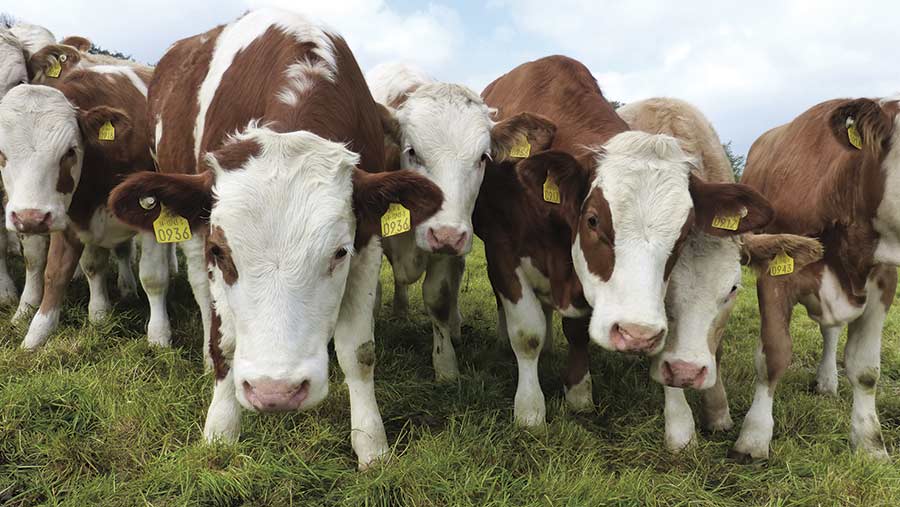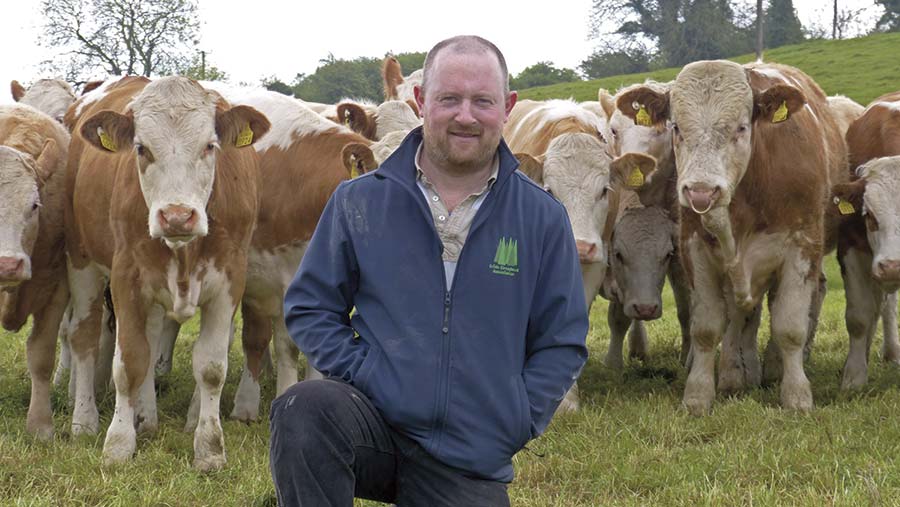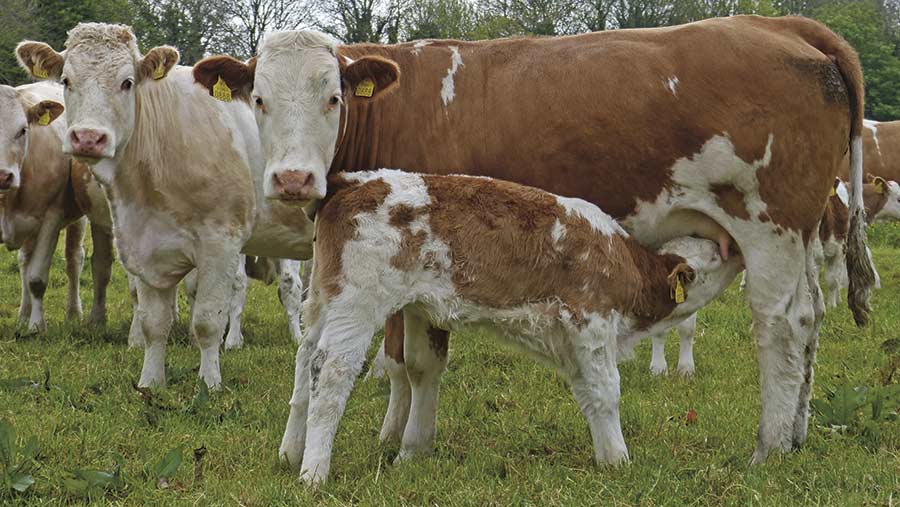How Ireland’s five-star cows are improving beef performance
Using a five-star rated system to assess herd performance is increasing a Simmental herd’s profitability and efficiency.
Clonakilty farmer Tommy Moyles has increased his herd size 60% by selecting easy-calving cows with low birthweights and reducing mature cow size by 10%.
Average cow weight in the spring-calving herd is 671kg, with the deadweight producer aiming for a herd at 650kg.

© Michael Priestley/RBI
See also: Is bigger better when it comes to cow size?
Moyhan herd facts
- 80 head of Simmental based herd including pedigrees
- Closed herd since 1999
- Natural service, breeding heifers at 13-15 months
- Spring calving 29 January to 5 April (10 weeks)
- Housed from October to February
- Minimal concentrates on breeding stock
- Supplying culls to Dawn Meats and bulls to Kepak
- Annual rainfall: 1,300mm
Alongside increasing grassland production by rotational grazing, moderate-framed cattle are enabling the Moyhan herd, Ardfield, to be farmed more efficiently.
There are now 80 females on the Cork coast farm, all rigorously recorded as part of the national BDGP programme paying farmers involved a subsidy tied to the land.
The system rates cows on milk performance, fertility performance and carcass progeny, with all abattoir and farm data pooled centrally in the Irish Cattle Breeding Federation (ICBF) database.
Over half the herd is five-star rated (within the top 20% of the breed) by the BDGP, which Mr Moyles says includes some of his biggest and smallest cows.
“We have five-star cows that are more than 800kg, the key thing is finding them,” he explains. “A seven-year-old is 840kg and rated highly but then again so is a four-year-old only weighing 586kg.”
Mr Moyles’ focus has been to find the lighter and more efficient star performers.
Industry backlash
By subsidising farmers €80-€95 (£70-£83) a cow on average, the BDGP requires breeders to rate cattle performance objectively and only use four or five-star bulls.
“It has caused a bit of upset in the industry for sure,” admits Mr Moyles. “People are being told their favourite cow is their worst cow, which is hard to accept.
People are being told their favourite cow is their worst cow, which is hard to accept Tommy Moyles
“When people realised you didn’t need all your cows to be four or five-star cows things calmed down.”
But for the Moyhan herd, involvement in the data programme is a “no brainer” where easy calving credentials, managing good weaning weights and fertility are priorities.
The programme stipulates that by 2018 and 2020 the Moyhan herd must contain 12 and then 29 four or five-star cattle to qualify for payments with the BDGP. However, because Mr Moyles is ahead of the curve, 52 cows rating four and five star (90%) at the start of 2016.

Tommy Moyles © Michael Priestley/RBI
Farms enter the programme for six years and receive €142.5 (£125.61) for the first 6.6ha of forage land and €120 (£105) thereafter.
- Calving details: Calf, calving ease and sire number to be registered within 27 days of birth. All persistently infected stock with bovine viral diarrhoea must be removed
- Surveys: Cows, calves and bulls need specific surveys on calf vigour, docility, culling reasons, performance, pneumonia and scour
- Genotyping: Mr Moyles genotypes all stock under the scheme. Can be only 60% according to herd size
- Replacements: Sires must be at least 80% four or five stars if AI or have one four of five-star stock bull. Farms given three years to reach 20% of cows rated at four or five stars and five years to have 50% rated four or five stars
- Carbon Navigator: Farms must complete a carbon navigator assessment with an advisor to estimate financial and emissions savings possible on your holding for example, grazing season length, slurry spreading, fertiliser use
- Attend a training course on the scheme
How Mr Moyles uses the scheme
All Moyhan stock are genotyped with a tissue tag under the BDGP. Information is fed back from the ICBF to the farm which is considered and helps inform breeding decisions.
See also: Genomic breeding value to shake up Limousin bull rankings
“If I was using more AI and my herd wasn’t closed then this information would be even more useful to me,” explains Mr Moyles.
“Generally, I pick bulls with calving ease in mind. They must be high replacement index as well as being polled as I’m trying to go down that route.”
He says the BDGP puts pressure on herds grading up their proportion of four or five-star cows to 20% and then 50% but because of the farm’s commercial focus, this was easily achieved.
All main breeds have star ratings, including; Aubrac, Parthenaise and Piedmontese and star ratings are also given “across all breeds”. All stock in the scheme are split into 20% increments, with a five-star cow being in the top 20% for the breed and a one star cow being in the bottom 20%.
Star ratings are checked by inserting an animal’s AI code or tag number into the ICBF website. Ratings are updated in April, August and December.
To qualify for payment under the BDGP all calves have to be weighed and a calving ease (1-4) and vigour score is also given. A caesarian earns 4, 3 is a calving jack, 2 is some assistance and 1 is unassisted.
Calving scores this year stand at 1.38 on average. A camera is fixed in the calving shed, which has allowed the cows to be monitored easily.
Since recording average birthweight has been lowered from 40kg to 38kg.
Calving ease and fertility are essential for a good rating in the scheme, which targets a beef cow having a calf every year.
“You can’t see fertility so the priority is a short breeding window,” adds Mr Moyles. “We usually manage 95% of cows in calf within 10 weeks.”
A small number of the pedigree cows are AI’d to pure Simmental, while Simmental stock bulls carry out 90% of services on the farm.
Benefits of the scheme
As well as being able to increase herd size, the herd is becoming more productive. In 2016, 66 cows calved weaning 47% of their weight off grass, silage and only 1.07kg of concentrates a head, mostly which went to train heifers. This was above their three-year average of 43%.
Stocking more cows and higher weaning weights mean the farm has weaned 4,394kg (liveweight) more calves in 2016 than in 2013.
And while efficient cows are giving more calves to sell each year, they also meet the deadweight specifications at Kepak, says Mr Moyles.
The last kill sheet showed 86% of bulls achieved R+ grade and 75% U grade from an ad-lib silage/straw and a 13ME 17CP finisher pellet diet for 100 days at 8.5kg a head a day in the final month with an average slaughter age of under 14 and a half months, earning the farm £2.29/day before costs.

© Michael Priestley/RBI
Moyhan weaning weights |
|||
|
Year |
Herd weight |
Calf weight |
Weaning % |
|
2013 |
35,585kg |
15,938kg |
44.7% |
|
2016 |
42,055kg |
20,332kg |
48% |
|
Pros and Cons of the five-star system |
|
|
For |
Against |
|
Subsidy Farmers are being paid a subsidy linked to hectares farmed in an era of a shrinking subsidy pot. Some think the subsidy should be two or three times as much to make up for rearing smaller calves |
Inbreeding Forcing people to select five-star bulls is tightening the gene pool. Some breeds fear 70% of the herd book could be from three or four bloodlines in four year’s time |
|
Objectivity Grading cows on weaning half their weaning weights and their feed conversion efficiency is boosting the efficiency of Irish herds. |
Loss of shape and muscle European live exports are important to Irish store cattle prices and can be at a €150 (£131) a head premium. In 2016 145,000 cattle were exported worth €100m (£87m). Modern indexes reward easy-calving, smaller cows. |
|
Costs Maintenance requirements of cattle is a key cost factor for suckler farms. By selecting cows that are consistently five star a farm can have the same number of cows on less land. Similarly, labour needed to monitor calving pens is reduced by easier calving cattle. |
Confusion Star ratings rise and fall as bulls and cows become more “proven” and data builds. This is hard for producers to grasp and leaves question marks over marketing bulls. A cow with poor back breeding can improve her star rating with her calves on the ground |
|
Carbon The BDGP aims to select for efficient cows. These are cows that will produce a saleable calf every year and thus reduce the environmental impact of beef production, thus addressing sustainability and marketing issues for the beef sector. |
Lack of reliability Bulls aren’t phased into the scheme, they are simply added to the rating system with no proven information. Reliability of proven bulls matters and factors in the many landscapes and management strategies of Irish suckler production. |
|
Source: Peadar Glennon, Irish Simmental Cattle Society, and Paul Sykes, Irish Limousin Cattle Society. |
|
